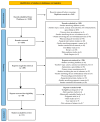The Efficiency of Rehabilitation Therapy in Patients Diagnosed with Neurogenic Bladder: A Systematic Review
- PMID: 39064583
- PMCID: PMC11278912
- DOI: 10.3390/medicina60071152
The Efficiency of Rehabilitation Therapy in Patients Diagnosed with Neurogenic Bladder: A Systematic Review
Abstract
Considerable research efforts have been directed towards investigating neurogenic bladder dysfunction over the preceding decade. This condition stands as the most prevalent and incapacitating pelvic floor disorder amidst patients afflicted with specific upper motor neuron syndromes, including multiple sclerosis, stroke, and spinal cord injury. The current study aims to bring up-to-date findings on rehabilitation methods for treating neurogenic bladder. The Web of Science database (MEDLINE, PsychINFO, EMBASE, CENTRAL, ISRCTN, and ICTRP) was screened for randomized controlled studies and clinical studies using combinations of keywords including "neurogenic bladder", "stroke", "multiple sclerosis", and "spinal cord injury". The PEDro scale was used to assess the quality of the articles included in this study. After a thorough examination, eleven articles met the criteria for inclusion in our research. The outcome measures showed a variety of forms of electrostimulation that can be combined with or without PFMT. These interventions significantly enhance health-related quality of life, as evidenced by various assessment methods. The physical approach constitutes an effective therapeutic method that can reduce the severity of urinary incontinence.
Keywords: electrophysical agents; multiple sclerosis; neurogenic bladder; pelvic floor; physical therapy; rehabilitation; spinal cord injury; stroke.
Conflict of interest statement
The authors declare no conflicts of interest.
Figures


References
-
- Santiago J., Cameron A.P., Navarrete R.A. Addressing Sphincter Dysfunction in the Female with Neurogenic Lower Urinary Tract Dysfunction. Curr. Bladder Dysfunct. Rep. 2020;15:142–152. doi: 10.1007/s11884-020-00597-x. - DOI
-
- Vaughan C.P., Fitzgerald C.M., Markland A.D. Management of Urinary Incontinence in Older Adults in Rehabilitation Care Settings. Curr. Phys. Med. Rehabil. Rep. 2019;7:159–169. doi: 10.1007/s40141-019-00221-y. - DOI
-
- Vaughan C.P., Markland A.D., Smith P.P., Burgio K.L., Kuchel G.A. Report and research agenda of the American Geriatrics Society and National Institute on Aging bedside-to-bench conference on urinary incontinence in older adults: A translational research agenda for a complex geriatric syndrome. [(accessed on 2 May 2024)];J. Am. Geriatr. Soc. 2017 66:773–782. doi: 10.1111/jgs.15157. Available online: https://agsjournals.onlinelibrary.wiley.com/doi/10.1111/jgs.15157. - DOI - DOI - PMC - PubMed
-
- Abrams P., Cardozo L., Fall M., Griffiths D., Rosier P., Ulmsten U., Van Kerrebroeck P., Victor A., Wein A. The standardisation of terminology in lower urinary tract function: Report from the standardisation sub-committee of the International Continence Society. Urology. 2003;61:37–49. doi: 10.1016/S0090-4295(02)02243-4. - DOI - PubMed
Publication types
MeSH terms
LinkOut - more resources
Full Text Sources
Miscellaneous

